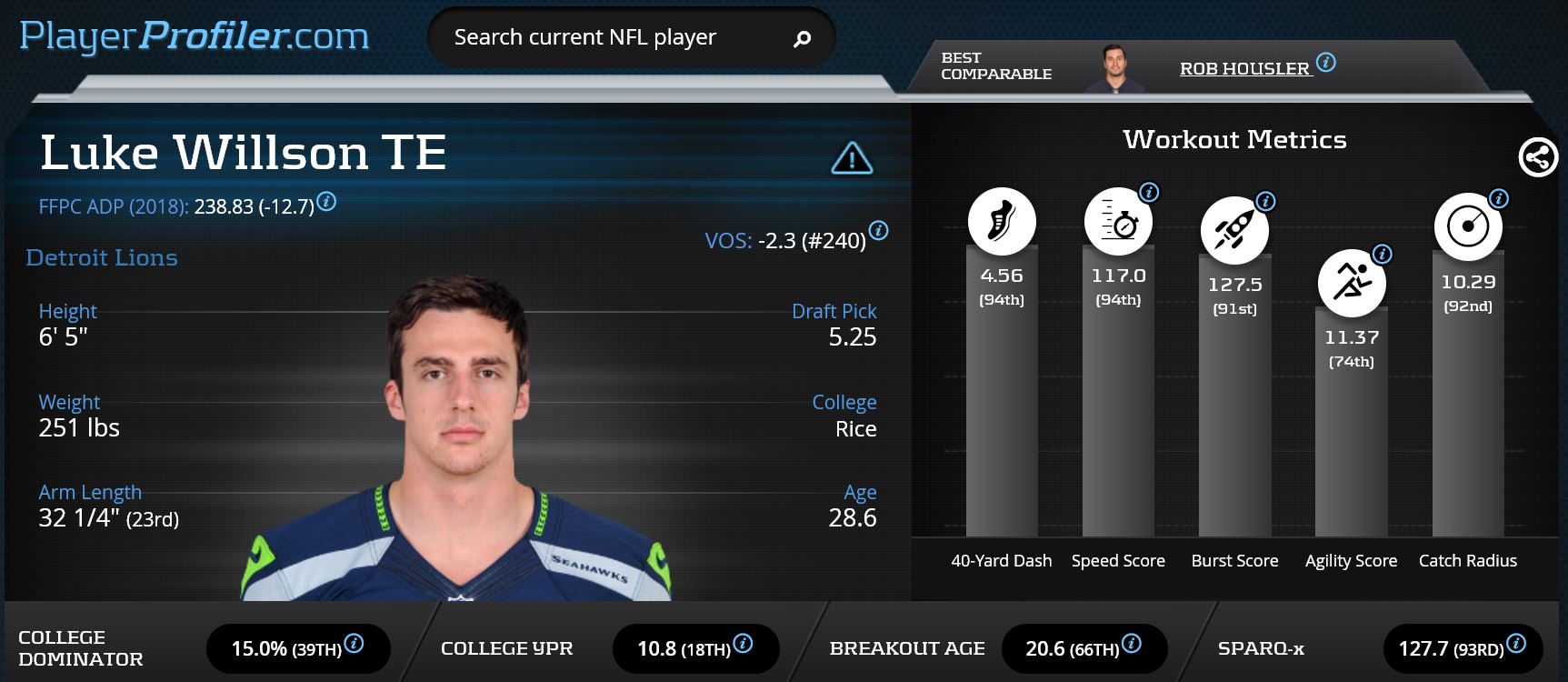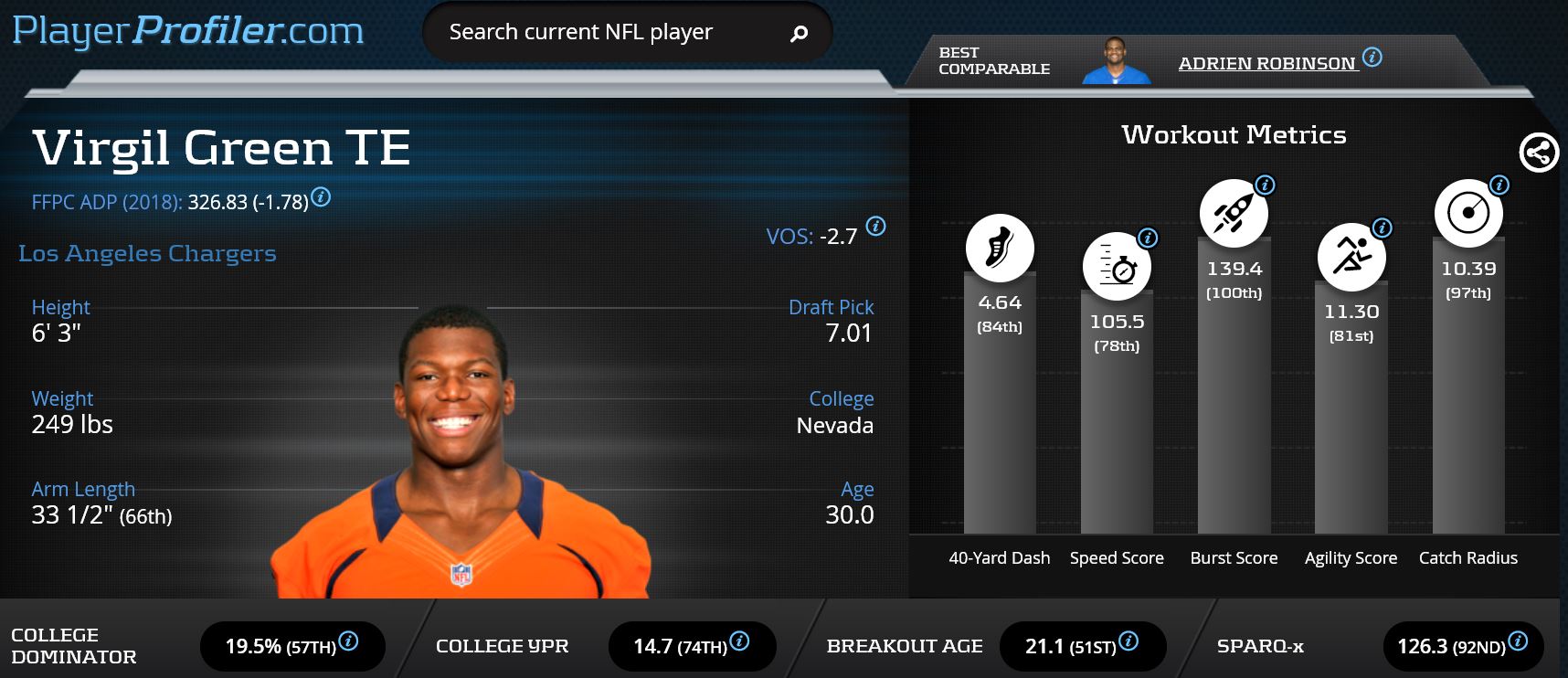Playing the tight end position at the NFL level is a grueling task. Playing the tight end position in fantasy football, while not physically grueling, is a challenge nonetheless. There’s a certain safety that comes with the feeling of drafting Rob Gronkowski or Travis Kelce. One won’t scour the waiver wire to play match-ups if they own a top tier player at the position. Leagues with tight end premiums and/or multiple flex spots are growing increasingly popular. So it’s understandable if the allure of owning an elite player or two at a historically fragile position such as tight end is too much to pass up.
There are also plenty of reasons to not spend early draft capital chasing tight end production. Tight ends must learn the blocking assignments for all the run plays and the routes for all the pass plays, so they’re always at risk of injury. It’s why the fragility rate is the highest among the fantasy skill positions, making tight end output the most volatile and difficult to forecast year-to-year next to running back. Add in a draft-capital adjusted bust rate that can rival that of the RB position. The argument in favor of playing Late Round Tight End Roulette has no choice but to strengthen.
Lost Season of 2017
Of last year’s Late Round Tight End Roulette recommendations, the best player was Austin Seferian-Jenkins who finished with 7.9 (No. 17) Fantasy Points per Game. There were 17 tight ends who finished with double digit FPPG in 2016, but only nine players hit that mark last year. 2016’s double-digit point scorers were all within 0.7 points per game of each other. But with third-place Zach Ertz (14.5) finishing so much higher than fourth-place Evan Engram (11.6) last year, it’s no surprise that fantasy gamers who waited on tight end had so much trouble finding stability at the position.
An under-reported fantasy story of the 2017 season was the decline of the quarterback position and how it negatively affected the wide receiver and tight end landscape. While qualified QBs averaged 15.59 FPPG in 2016, that number dropped by over half a point to 15.08 last year. Naturally, the FPPG output also dropped by over half a point at both wide receiver (7.92 to 7.24) and tight end (5.96 to 5.45).
This can partially be explained by the influx of elite-level running backs over the last three seasons (aka: the Running Back Renaissance). It was also partly because many quarterbacks were bitten by the injury bug. Whether it was Derek Carr playing with a transverse process fracture in his back or Andrew Luck and Aaron Rodgers missing significant time, the position was snake bitten in 2017. If last year’s injured players can regain their pre-injury form, it will go a long way towards stabilizing the FPPG production across all positions in 2018.
Ideal Late Round Tight End Profile
The best-value tight ends in fantasy are those who fit the Rob Gronkowski/Travis Kelce-like stud archetype. They hover around 6-5, 250-plus pounds and boast exceptional weight-adjusted agility, increasing the likelihood of them playing on every down or close to it. It’s easier on paper than it is in practice to uncover the correct values in fantasy drafts. When the double-digit rounds hit and most of the other owners have at least drafted their starter, that’s the time to start throwing darts at the right kinds of players. When waiting that long, it doesn’t make sense to play it safe with Charles Clay when there’s more upside available.
The influx of precocious talents who have displayed professional efficiency within the first two years of their careers will make the late-round tight end strategy viable in the years ahead. The fact that the position has disappointed fantasy gamers over the last few years is creating massive buying opportunities for those who choose to wait it out in drafts. First-year LRTE subjects Tyler Eifert and Austin Seferian-Jenkins have ADPs outside the Top 100 players in high-stakes formats, which makes narrowing down the list of LRTE Roulette candidates to five more difficult. Granted these specific players come with injury and situational red flags, respectively, but it speaks to the depth of the position and the viability of the LRTE strategy in 2018.
One player who would’ve been featured prominently had he not separated his shoulder in the preseason opener is George Kittle. The main trait that led us to uncover Tyler Eifert and Austin Seferian-Jenkins was exceptional weight-adjusted agility. At close to 250 pounds, Kittle boasts a 10.83 (100th-percentile) Agility Score. It’s encouraging that he translated his exceptional athleticism into professional efficiency at a position where first-year players rarely shine. While Garrett Celek, with his 4th-percentile College Dominator Rating and 36th-percentile athleticism, won’t keep Kittle from happening, it’s never smart to draft players when you know they’re dealing with an injury. Kittle enthusiasts have to hope he starts the season on a slow enough note that he becomes a viable trade target later on.
O.J. Howard, Buccaneers
O.J. Howard and David Njoku are the poster children for the influx of precocious tight end talents into the NFL. Both are optimal late-round targets for owners who want to swing for home runs. Though the Browns have one win in the last two seasons, Njoku is the more expensive player to acquire. Howard finished at or near the top of nearly every relevant efficiency metric in his rookie year. This was a result of scoring six times on 26 receptions.
https://www.youtube.com/watch?v=woEhvrl4CRA
O.J. Howard only played on 64.8-percent of the offensive snaps in 2017, and his Route Participation of 34.3-percent was the second-worst among qualifying players. Both Cameron Brate and Mike Evans signed long-term deals and will continue to be touchdown scoring threats. But like he did in his rookie year, a player with Howard’s pedigree and weight-adjusted athleticism will find a way to be a factor. The hard part was being able to establish on-field competency so early in his professional career. For the top-five upside, Howard’s price point is the best among all tight ends in fantasy football this year.
Jack Doyle, Colts
When a team is projected to improve the way that the 2018 Indianapolis Colts are, it makes sense to target their skill position players in drafts. Jack Doyle doesn’t have the kind of athletic profile that should inspire any fantasy gamer to pound the table for him. But with two consecutive seasons of positive efficiency, including a year without Andrew Luck, it’s time to contend that Doyle is hash-tag good at football.
https://www.youtube.com/watch?v=kHwAr3VTOEo
With no second or third wide receiver of consequence on the roster, Frank Reich will run a tight-end heavy offense featuring Jack Doyle and new addition Eric Ebron. The only tight end with more targets last year than Doyle on passes within 15 yards of the line of scrimmage was Zach Ertz, Reich’s former tight end. And while Ebron projects to see offensive involvement, he won’t come close to Doyle’s 99.9-percent (No. 2) Snap Share from a season ago. Doyle’s likelihood of being on the field in all high-leverage situations, along with his established rapport with Andrew Luck, makes him a no-brainer selection if he slips to the double-digit rounds of seasonal leagues.
Jared Cook, Raiders
Despite being something of a fantasy punchline over the years, Jared Cook had a good first season in Oakland. Though Michael Crabtree and Amari Cooper scored 15 TDs between them, Cook led the team with 687 receiving yards. All of Oakland’s pass catchers suffered statistically as a result of Derek Carr playing hurt for much of the season. It’s unusual to see a player who finished 14th in Fantasy Points Per Game being drafted outside the Top 20 at his position. But the Cook fatigue is real, and a buying opportunity has presented itself.
https://www.youtube.com/watch?v=S0LqjsloeSw
Though the 2018 Raiders will look different under John Gruden’s leadership, the now-veteran presence of Jared Cook on the roster can’t be ignored. Though Jordy Nelson still has juice left, he can’t be expected to make a consistent impact right away as a 33-year old receiver switching teams for the first time in his professional career. And while Martavis Bryant‘s upside is tantalizing, he’s always a suspension risk and is reportedly struggling to learn the playbook. Cook is in a great position to be able to at least match his numbers from last year. A bump in the TD department, which is attainable with a healthy Derek Carr, and he can flirt with a Top 12 positional finish.
Luke Willson, Lions
With a SPARQ-x score above the 90th percentile and a College Dominator Rating that didn’t eclipse the 40th percentile, Luke Willson is the kind of player that we usually avoid in fantasy football. He’s an exceptional athlete who under-performed his athleticism at the college level. Players like these have had many cautionary tales written about them over the years (see Jared Cook). But not many college players share the field with a player at the same position who gets drafted by the NFL in the same year, especially at the tight end position. Despite sharing the field for four years at Rice with second round pick Vance McDonald, Willson was still chosen by Seattle in the fifth round of the 2013 NFL Draft.
Despite being stuck behind Jimmy Graham on the depth chart for the past three years, Luke Willson has recorded a positive Production Premium in each of his first five seasons in the league. Now he has a chance to start in Detroit. With former starter Eric Ebron posting Target Shares of 15.2-percent in 2017 and 15.4-percent in 2016, Willson is set to surpass his career-high 12.3-percent Target Share from 2014. His elite athleticism and plus weight-adjusted agility will be an asset for Matthew Stafford and his short-passing offense. And if he can carve out a red zone role on a team without an established dominant presence in that area of the field, it’s wheels up for Luke Willson.
Virgil Green, Broncos
In seven seasons with the Denver Broncos, Virgil Green recorded 71 receptions in 100 games. Despite being an elite athlete with a 126.3 (92nd-percentile) SPARQ-x score and an above average 19.5-percent (57th-percentile) College Dominator Rating, he’s been labeled a blocker for his entire career. It’s not unusual for tight ends to take a long time to develop at the professional level. But one would expect a player with 100th-percentile burst, 81st-percentile agility and a 10.39 (97th-percentile) Catch Radius to take more than seven years to become usable in fantasy leagues.
If there was ever a time for Virgil Green to become a fantasy commodity, it’s this season. A team he faced twice a year signed him to a three-year contract. The one player ahead of him on the depth chart, Hunter Henry, was lost for the year with a torn ACL. Keenan Allen will handle a monster Target Share, but there’s room for other players to make fantasy contributions with Phillip Rivers still playing at a high level. Green is a complete afterthought in both casual and high-stakes leagues. The potential to be the latest in a string of late-career tight end breakout success stories is there.




